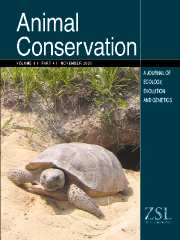Crossref Citations
This article has been cited by the following publications. This list is generated based on data provided by
Crossref.
Purvis, Andy
and
Hector, Andy
2000.
Getting the measure of biodiversity.
Nature,
Vol. 405,
Issue. 6783,
p.
212.
Brooks, Thomas M.
Mittermeier, Russell A.
Mittermeier, Cristina G.
Da Fonseca, Gustavo A. B.
Rylands, Anthony B.
Konstant, William R.
Flick, Penny
Pilgrim, John
Oldfield, Sara
Magin, Georgina
and
Hilton‐Taylor, Craig
2002.
Habitat Loss and Extinction in the Hotspots of Biodiversity.
Conservation Biology,
Vol. 16,
Issue. 4,
p.
909.
Grelle, C. E. V.
Alves, M. A. S.
Bergallo, H. G.
Geise, L.
Rocha, C. F. D.
Sluys, M.
and
Caramaschi, U.
2005.
Prediction of threatened tetrapods based on the species–area relationship in Atlantic Forest, Brazil.
Journal of Zoology,
Vol. 265,
Issue. 4,
p.
359.
Brito, Daniel
Grelle, Carlos Eduardo V.
and
Boubli, Jean Philippe
2008.
Is the Atlantic Forest protected area network efficient in maintaining viable populations of Brachyteles hypoxanthus?.
Biodiversity and Conservation,
Vol. 17,
Issue. 13,
p.
3255.
Forero-Medina, German
Vieira, Marcus Vinícius
Grelle, Carlos Eduardo de Viveiros
and
Almeida, Paulo Jose
2009.
Body size and extinction risk in Brazilian carnivores.
Biota Neotropica,
Vol. 9,
Issue. 2,
p.
45.
Pinto, Míriam Plaza
and
Grelle, Carlos Eduardo Viveiros
2009.
Reserve selection and persistence: complementing the existing Atlantic Forest reserve system.
Biodiversity and Conservation,
Vol. 18,
Issue. 4,
p.
957.
Galetti, Mauro
Giacomini, Henrique C.
Bueno, Rafael S.
Bernardo, Christine S.S.
Marques, Renato M.
Bovendorp, Ricardo S.
Steffler, Carla E.
Rubim, Paulo
Gobbo, Sabrina K.
Donatti, Camila I.
Begotti, Rodrigo A.
Meirelles, Fernanda
Nobre, Rodrigo de A.
Chiarello, Adriano G.
and
Peres, Carlos A.
2009.
Priority areas for the conservation of Atlantic forest large mammals.
Biological Conservation,
Vol. 142,
Issue. 6,
p.
1229.
Bird, Jeremy P.
Buchanan, Graeme M.
Lees, Alexander C.
Clay, Rob P.
Develey, Pedro F.
Yépez, Itala
and
Butchart, Stuart H. M.
2012.
Integrating spatially explicit habitat projections into extinction risk assessments: a reassessment of Amazonian avifauna incorporating projected deforestation.
Diversity and Distributions,
Vol. 18,
Issue. 3,
p.
273.
Wearn, Oliver R.
Reuman, Daniel C.
and
Ewers, Robert M.
2012.
Extinction Debt and Windows of Conservation Opportunity in the Brazilian Amazon.
Science,
Vol. 337,
Issue. 6091,
p.
228.
Pinto, Míriam Plaza
Silva-Júnior, José de Sousa e.
Lima, Adriana Almeida de
Grelle, Carlos Eduardo Viveiros
and
Sueur, Cédric
2014.
Multi-Scales Analysis of Primate Diversity and Protected Areas at a Megadiverse Region.
PLoS ONE,
Vol. 9,
Issue. 8,
p.
e105205.
Grelle, Carlos E. V.
Rajão, Henrique
and
Marques, Marcia C. M.
2021.
The Atlantic Forest.
p.
487.
Grelle, Carlos E. V.
Bayma, Adriana Panhol
Paixão, Luciane Rodrigues Lourenço
Egler, Mariana
Senta, Mateus Motter Dala
Jenkins, Clinton N.
Uezu, Alexandre
Pellin, Angela
Martensen, Alexandre Camargo
Shirai, Henrique
Soares, Neluce
Lima, Fernando
Fernandez, Eduardo
Pougy, Nina
Martinelli, Gustavo
Mesquita, Carlos Alberto
Mantovani, Mario
Fernandez, Fernando A. S.
Rheingantz, Marcelo L.
and
Vieira, Marcus Vinicius
2021.
The Atlantic Forest.
p.
421.
Grelle, Carlos E. V.
Niemeyer, Julia
Viveiros de Castro, Ernesto B.
Lanna, André M.
Uzeda, Mariella
and
Vieira, Marcus Vinicius
2021.
Sustainability issues in a tropical mega trail.
Royal Society Open Science,
Vol. 8,
Issue. 3,
N. Winter, Steven
Eastwood, Gillian
and
A. Barrios-Izás, Manuel
2023.
Forest Degradation Under Global Change.
Vol. 3,
Issue. ,


